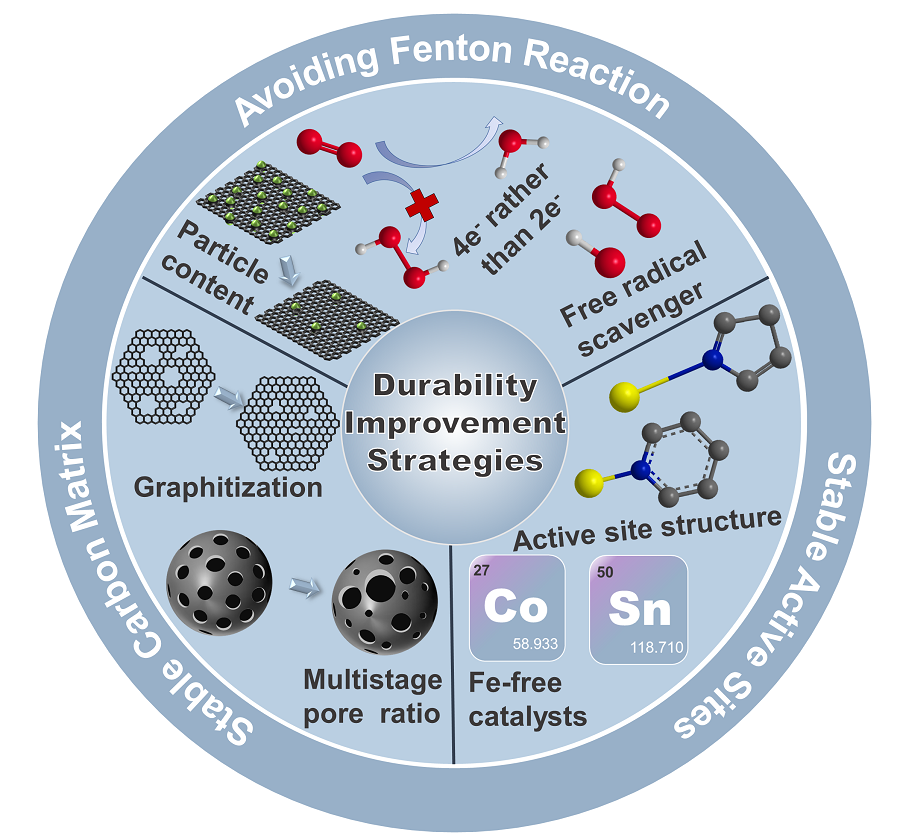 PDF(13985 KB)
PDF(13985 KB)


Degradation Mechanisms and Durability Improvement Strategies of Fe-N-C Catalysts for Oxygen Reduction Reaction
Longhao Li, Wei Zhou, Liang Xie, Chaowei Yang, Xiaoxiao Meng, Jihui Gao
Prog Chem ›› 2024, Vol. 36 ›› Issue (3) : 376-392.
 PDF(13985 KB)
PDF(13985 KB)
 PDF(13985 KB)
PDF(13985 KB)
Degradation Mechanisms and Durability Improvement Strategies of Fe-N-C Catalysts for Oxygen Reduction Reaction
Among the many non-precious metal catalysts that have been reported so far, M-N-C catalysts based on transition metal-nitrogen-carbon structure are considered as the most promising candidates to replace Pt-based catalysts for oxygen reduction reaction. Compared with other M-N-C catalysts, Fe-N-C catalysts exhibit the highest ORR activity in acidic environments due to the suitable adsorption energy of oxygen-containing intermediates and thermodynamically favorable 4e pathway. However, the practical application of this catalyst is still limited by the challenge of insufficient stability under the high voltage and strong acidic conditions of PEMFC. Thus, the preparation of stable and efficient Fe-N-C catalysts still faces many challenges. In this review, we systematically summarize the common synthesis methods of Fe-N-C catalysts, including spatial confinement method and template-assisted strategy, outline the half-cell and single-cell test methods used to evaluate the catalyst stability, and analyze the reasons for the discrepancies between the two test results. In order to design highly stable catalysts, a clear knowledge and understanding of the degradation mechanism is required, so we describe four possible degradation mechanisms for Fe-N-C catalysts: demetallization, carbon oxidation, protonation, and microporous water flooding, subsequently we propose some specific strategies to enhance the stability of Fe-N-C catalysts. Finally, the future development direction of Fe-N-C catalysts is discussed in this review. It is hoped that the comprehensive and in-depth study of Fe-N-C catalysts will guide the design and development of highly stable Fe-N-C catalysts for the application of PEMFC.
1 Introduction
2 Synthesis methods of Fe-N-C catalysts
2.1 Spatial confinement method
2.2 The template method
2.3 Other methods
3 Stability test protocols for Fe-N-C catalysts
3.1 Half-cell test
3.2 Single-cell test
3.3 Analysis of the variability of the results of the two test protocols
4 Degradation mechanisms of Fe-N-C catalysts
4.1 Demetalation
4.2 Carbon crossion
4.3 Protonation
4.4 Water flooding in microporous
5 Durability improvement strategies of Fe-N-C catalysts
5.1 Stable carbon matrix
5.2 Stable active sites
5.3 Avoiding fenton reaction
6 Conclusion and outlook

proton exchange membrane fuel cell / oxygen reduction reaction / Fe-N-C electrocatalysts / stability / degradation mechanisms / durability improvement strategies
| [1] |
|
| [2] |
|
| [3] |
|
| [4] |
|
| [5] |
|
| [6] |
|
| [7] |
|
| [8] |
|
| [9] |
|
| [10] |
|
| [11] |
|
| [12] |
|
| [13] |
|
| [14] |
|
| [15] |
|
| [16] |
(孟鹏飞, 张笑容, 廖世军, 邓怡杰. 化学进展 2022, 34(10): 2190.).
|
| [17] |
|
| [18] |
|
| [19] |
|
| [20] |
|
| [21] |
|
| [22] |
|
| [23] |
|
| [24] |
|
| [25] |
|
| [26] |
|
| [27] |
|
| [28] |
|
| [29] |
(杨孟蕊, 谢雨欣, 朱敦如. 化学进展, 2023, 35(5): 683.).
|
| [30] |
|
| [31] |
|
| [32] |
|
| [33] |
|
| [34] |
|
| [35] |
|
| [36] |
|
| [37] |
|
| [38] |
|
| [39] |
|
| [40] |
|
| [41] |
|
| [42] |
|
| [43] |
|
| [44] |
|
| [45] |
|
| [46] |
|
| [47] |
|
| [48] |
|
| [49] |
|
| [50] |
|
| [51] |
|
| [52] |
|
| [53] |
|
| [54] |
|
| [55] |
FCCT. US DOE. 2013. https://www.energy.gov/sites/prod/files/2015/08/f25/fcto_dwg_usdrive_fctt_accelerated_stress_tests_jan2013.pdf.
|
| [56] |
|
| [57] |
|
| [58] |
|
| [59] |
|
| [60] |
|
| [61] |
|
| [62] |
|
| [63] |
|
| [64] |
|
| [65] |
|
| [66] |
|
| [67] |
|
| [68] |
|
| [69] |
|
| [70] |
|
| [71] |
|
| [72] |
|
| [73] |
|
| [74] |
|
| [75] |
|
| [76] |
|
| [77] |
|
| [78] |
|
| [79] |
|
| [80] |
|
| [81] |
|
| [82] |
|
| [83] |
|
| [84] |
|
| [85] |
|
| [86] |
|
| [87] |
|
| [88] |
|
| [89] |
|
| [90] |
|
| [91] |
|
| [92] |
|
| [93] |
|
/
| 〈 |
|
〉 |